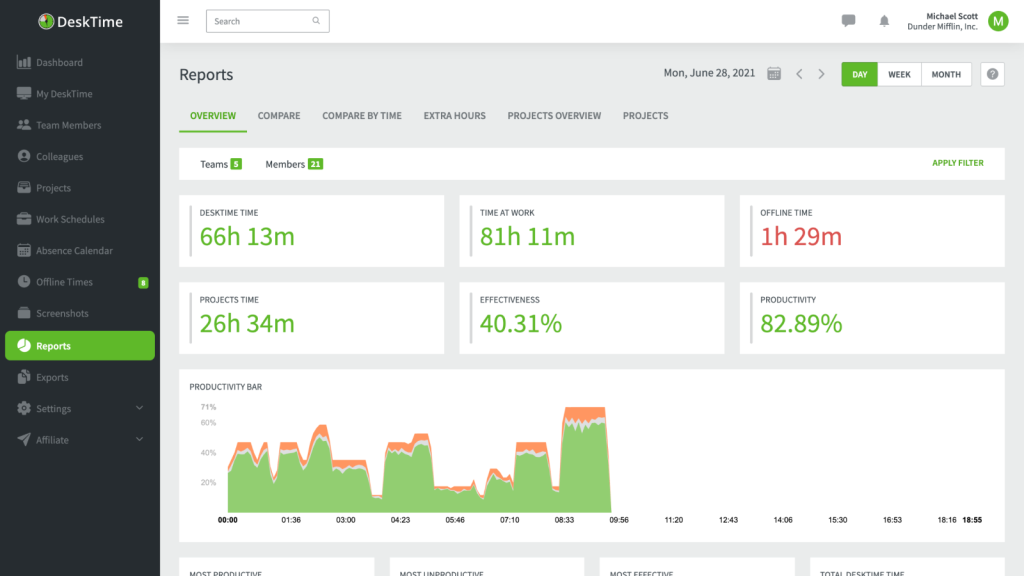How to improve your time management using time tracking software: 6 approaches that WORK

From identifying your principal distractions to conducting productivity experiments – this article explains how you can use your time tracking software to become a more productive person.
These approaches really work (we’ve tested them!) and what’s better:
They work for everyone.
But mind you:
This is not one-size-fits-all advice but rather tips that encourage you to evaluate what works best for you, individually. You may be working in a big corporate office or you may be freelancing from home.
In any case, you can follow these productivity suggestions and have fun while you’re at it.
Want to get the most out of your time?
Try DeskTime for free!
Try free for 14 days · No credit card required.
By signing up, you agree to our terms and privacy policy.

Approach #1: Identify your peak productivity hours…
…and guard them like your life depends on it.
Naturally, our productivity levels vary throughout the day. For some of us, concentration is more powerful in the morning, while others will report feeling more productive in the afternoon.
There’s ample advice on the internet about how to work better and smarter. However, each of us is unique and what works for others might not be the best solution for you. Therefore, if you are looking for ways to improve YOUR time management, first you need to determine which are YOUR peak productivity hours.
How DeskTime can help:
Go to your DeskTime account and open your productivity bar for a specific day, week or month. Examine which hours or parts of the day show productivity peaks and which seem to be less productive.
Once you’ve determined the most productive parts of your day, schedule those exclusively for deep work. Taking calls, scheduling meetings, and performing smaller tasks can wait for that less active attention time.
This graph shows that this person’s most productive hours start after lunch. Therefore they should guard these precious concentration hours and rather answer emails, schedule meetings and make calls in the morning.

Approach #2: Use break reminders
You might have heard that taking regular breaks is essential for your wellbeing and productivity. But how frequent is “regular”? And how do you make breaking a habit?
We’ve got a data-backed answer to that.
Some time ago we conducted an experiment and found out that the most productive people had something in common – they took frequent and rather long breaks.
To be precise, they worked for 52 minutes and took breaks for 17 minutes, on average.
The main idea behind this work-break ratio is that you need to give your brain ample time to relax and recalibrate between intensive work sprints. The best way to recharge your mental batteries is to physically get up and leave your computer during your break.
If you are having difficulty forcing yourself to take a break, these creative tactics might help. One of the simplest (and the most effective) ways to make yourself take breaks at work is setting a reminder.
How DeskTime can help:
Right-click your DeskTime desktop app, click “Break time reminder” and set the break interval that you prefer.

A DeskTime popup will appear together with suggestions on what to do during your break.
Approach #3: Identify distractions and block them
We all procrastinate sometimes, for different reasons. Sometimes we don’t know how to start a complex task because we are afraid of it or even suffer from underlying imposter syndrome.
When you are stuck, it’s very tempting to click over to your go-to procrastination sites – be it social media, YouTube or the news. Your fingers automatically start typing domains like Facebook, Twitter and others. And there we are again – in a rabbit hole of messages, notifications, and feeds.
The worst part?
At the end of the day, you may feel less than happy with yourself because you haven’t gotten much work done. If you often find yourself in similar situations, it’s time to start controlling your relationship with distracting apps.
How DeskTime can help:
Go to your DeskTime account, select weekly or monthly view and scroll down to “Unproductive apps” section. Find out which distracting websites and apps take up most of your work time.

Then download a website blocking application like SelfControl or Freedom, and use it to block unproductive sites and apps when you’re struggling with a difficult task.
It’s up to you whether you block distractions for the whole day, part of the day, or for shorter periods. We’ve found it most effective to use blocking for an hour or two, when a deadline approaches or when we are stuck with a task that needs a breakthrough.

Need the motivation to sort out your day?
Start using time management software!
Approach #4: Adjust arrival time
Similarly to what we mentioned in Approach #1, it’s up to you to make smarter decisions regarding your individual productivity and improve your time management. Don’t always trust what others tell you about productivity and don’t rely on hunches.
For example, you might think you are a night owl because you love to sleep in. But paying closer attention to your productive and unproductive work hours can reveal a thing or two about when you are actually more efficient.
How DeskTime can help:
Go to your DeskTime account and select weekly or monthly view. Check your productivity graph and find the most productive parts of the day.
Adjust the time you arrive in the office to better suit the hours of your highest productivity. For example, if DeskTime tells you that your productivity soars in the morning, try going to sleep earlier and getting up an hour earlier to get to work ahead of time.
BONUS: If you get to work earlier, you can also leave work earlier and enjoy more time for relaxing and leisure activities in the evening.
Approach #5: Find out the actual time you spend working
Many of us work a set amount of hours, for example, from nine to five. For most of us, it simply means that we are at the office during this time, not that we are truly working. Truth is, you may be quite surprised to find out how many of those hours you spend at your desk doing work, de facto.
If you are confused about why a task or a project is not progressing well, take a look at the time you’ve actually spent working. Sometimes you’ve been in the office all day but don’t feel like you’ve made meaningful progress. For example, out of 8 hours at work, you may have spent as little as 4 or 5 hours truly working at your desk.
In short – if you’re trying to understand where your time is going, it’s worth taking a look at this metric.
Heads up – what you find out can be a little bit shocking.
How DeskTime can help:
Examine three key statistics on your DestTime account:
- Time at work (deduced from arrival and leaving time)
- DeskTime time (time spent at desk)
- Productive time (time spent using productive apps)

Approach #6: Conduct regular productivity experiments
You may have read inspiring articles on how, when and where to work. But that does not necessarily mean that the same tactics will work for you. And even the ones that worked last year may need adjusting because we all change and so does our productivity.
Conducting productivity experiments is a great way to constantly improve your time management. We’ve shared ideas for personal productivity experiments in this video:
For example, you can test your productivity using alternatives to the regular office desk and chair, like using a standing desk or a yoga ball. Or, you can try working from different places (e.g. home, office, coffee shop, library) and find out where you are most productive. Test working in the early morning or late in the evening. The sky is the limit!
How DeskTime can help:
Set up your own productivity experiments! Here’s how:
First, start paying attention and analysing your personal time tracking behavior. Notice anything interesting? For example, did your productivity soar last week when you worked from home? Or, have you noticed productivity peaks when you were listening to certain background music? Test your hypothesis and then adjust your work habits accordingly.
Improving your time management can be fun
Improving your productivity doesn’t necessarily require taking complex actions that are so difficult to follow that it even becomes counterproductive. In fact, we believe that you can improve your time management in an effortless and even fun way.
Using time tracking software can be very helpful in analysing your personal work performance, finding your strengths and pitfalls. Before starting to fix something you need to know exactly what needs fixing, right?
We tried all these approaches in practice – watch this video to see how it worked for us.
But don’t take our word for it – try them yourself!
Did you find this article useful? Give it a clap!
Psst! You can clap more than once if you really loved it 🙂